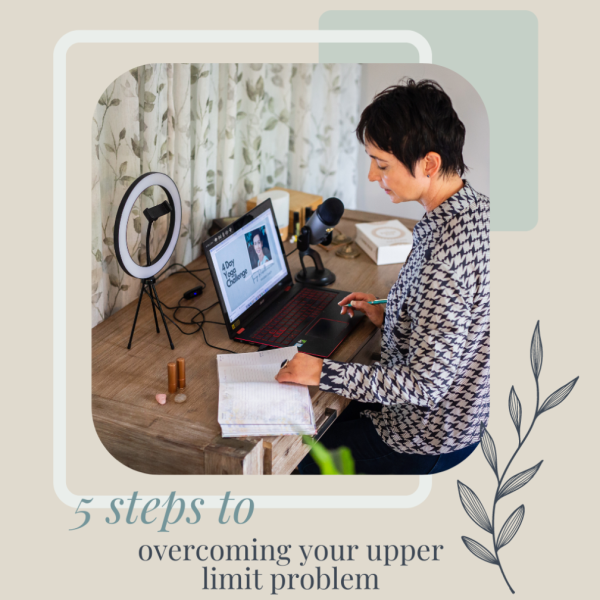Blog







Youch! And yay! I hit an upper limit problem!
What is an upper limit problem? I hear you ask.
An upper limit problem is a concept popularised by Psychologist and author Gay Hendricks, in his best selling book, The Big Leap. It relates to the belief that each one of us has, about how much happiness, abundance, success, love, etc. we are allowed to experience before things go wrong. The concept also supports the idea that on some level what we are seeking out of life isn’t happiness and abundance, but comfort and certainty.
Certainty is one of our core motivations as human begins. We like to be sure, (or certain). It provides us with a sense of stability from which we build our lives, and it motivates us to do things. For example, If, you were going to the movies. Would you be more or less motivated to go if you were unsure what was on and/or when? Studies show you are more likely to go to the movie (or do anything else) when there was a level of certainty to it. Of course, too much certainty creates boredom and too much uncertainty creates anxiety. Hendricks (2009) likened this tendency to an “inner thermostat setting”.
Hendricks (2009) theories that each one of us have our own thermostat of certainty, in relationship to the number of good feelings we allow ourselves to enjoy. In other words, we know the world is safe if we experience it in a set way, but when we experience an increased level of joy, success, or abundance, we become uncertain about what that might mean for us. Often this is not a conscious awareness. It sits just below our awareness until we choose to pay attention to it and explore it a little deeper. A bit like breathing. Most of the time we breath unconsciously, we trust our lungs to breath and keep us alive, nut if we want to we can bring our awareness to our breath and make some changes to it. A bit like this “internal happiness thermostat”
When we bring awareness to our ‘upper limits” there is an invitation to grow through our limiting beliefs or we are required to smash through our glass ceilings. This can be uncomfortable so, we have “upper limit strategies” to keep us safe, which presents as upper limit problems, inviting negative thoughts, or subconsciously engaging in unhelpful behaviours to bring us back down into the level of happiness with which we are most comfortable (or certain about).
Upper limit problems are a little sneaky as we often mask in our minds as simply “being realistic” “this always happen when things start going well”. Effectively creating self fulfilling prophecies. Not on purpose of course. Like I said, much of this happens on a subconscious level. The problem with upper limits is that they can really hold us back and have long lasting consequences that sabotage our potential and long term success.
Let me give you an example of real life upper limit I’ve recently experienced in my business. But first some background. I set up a yoga studio in New Zealand in 2004, alongside my main job training social workers and counsellors. Early 2022, amidst the chaos of Covid I decided to close my boutique yoga and coaching studio and move my business online. Now, I am no tech wizz but I know I can learn. My intention was to open an online community to help people create balance and enhance their lives. A place where people could learn about how our brains work, pick up some mindset tips, success strategies and be supported to set up their own home practice of yoga. I saw it as a way I could to really make a difference during these times.
So I decide. I show up. I learn. I do the work. I launch my first online membership.
I am so proud of myself for doing all those things and then…..my website crashes.
My website is all code. My portal is gone.
And I have the problem of a broken website.
I recognize it straight away as an upper limit problem.
Just knowing this prevents me from getting lost down the rabbit hole of negative thinking. Such as…
“ Why does this always happen it me?”
“I’m no good with IT, it always breaks’
“I should quit”
“It’s never going to work”
You can see how this type of thinking would serve as further evidence for other limiting beliefs that other people might have, like bad things always happen, things always go wrong.
But I recognize it as a growth opportunity. I decide to utilize this experience and write a blog about it and BOOM! I catch Covid. Another layer is revealed.
You see simply naming this as an upper limit issue and not buying into the negative thinking (outlined above) I am able to switch over into a growth mindset. I know there are always other ways to understand the world around us. Therefore, instead, of going down a rabbit hole of negative self talk, wasting time and energy. I am able, to name it, celebrate it and move on. In psychology we call this, a reframe.
From this space it is easy to apply some quality questions.
Like;
“How can I flip this? And change this problem into an opportunity”
Now, that my website has gone what opportunities does that open up?
Now, I had been “dating the idea” of rebranding Yoga Circle to a brand that incorporates yoga and my mindset coaching work for a while. Being unwell and needing to rest provided the time to really “sit with the idea” of rebranding. The website crash provided the timely need and the opportunity to implement that idea. So, watch this space and how things evolve with Tonya.
Now I imagine, you can see how this could have been a whole lot tricker had I not understood or recognized the upper limit problem. Being able to identify it quickly made so much easier to recognize what was going on and move forward. The reality is, when we hit an upper limit problem we have simultaneously reached an opportunity for success and to switch on our growth mindset. Thereby, challenging ourselves and grow through the problem, expand our potential, to experience even more abundance, joy, wellbeing in even more extraordinary ways.
Five ways to break through your upper limit problem
Simply knowing that upper limit problems happen because our brains are naturally wired to avoid risk and stay comfortable puts you in the position of power. Next time it happens you will be able to identify it and then you can choose how you respond in the future.
To help identify these problems in our futures we can gain some clues from our pasts. Can you think back to a time in your life when you experienced this type of “discomfort” as a result of success? For example, you deliver a course or presentation, or you get to the end of a tough term and then get sick? Things are really going well and then out of the blue you have a conflict with a loved one? Looking back can provide some insight into your unique “inner thermostat setting” and where your upper limits may lie. Just knowing this can help you pause, take a step back, do a reality check and question what’s going on. Just doing this step can be is enough to stop your brain from taking you down a rabbit hole of negative self talk.
- Celebrate
The next step is to celebrate. Celebrating involves reframe your discomfort. Seeing the discomfort as evidence of hitting an upper limit essentially flips it from “failure” to a success model. By acknowledging this feeling of discomfort as a positive sign you are in turn acknowledging all the hard work and risk you’ve taken to get where you are. It’s evidence “You are growing and learning.” You are on the right track. You are stepping into new territory and growing into the future of your dreams. This future requires you to grow into a new version of yourself and you can do it”.
- Decide to grow through it.
The next step is to decide. Decide to grow through it. I mean really decide. Decide so strongly that it is almost a knowing. See what you see, hear what hear and feel the feelings of being on the other side of this discomfort.
Applying quality questions like,
“How can I flip this? How can I transform this problem into an opportunity”
Provide the insights for step 4. Making it happen
- Make it happen. Take action.
Start where you are at with what you have.
What is the very first, smallest, easiest step you can make today?
Remember all steps in the right direction get you to your dreams.
- Keep going. It’s allowed to be uncomfortable; you can breathe through discomfort, and you can keep going. You are designed for this! When you get wobbly a deep breath is a good place to restart from.
Remember, “you can do it”. It’s your time, and oftentimes having a coach helps you grow through the sticky bits faster and easier. So if you need a hand or would like to learn more about how your mindset can really make a difference reach out.
Book your FREE 15-minute discovery call here.

